 Virtual Tour
Virtual Tour
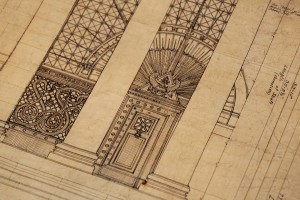 Welcome to the House of the Temple! We encourage you to spend a moment on our virtual tour and learn more about our unique building, galleries, and collections. While you are here, check out some rarely seen rooms that aren’t on the live tour, including the Grand Commander’s Suite and Temple Garden.
Welcome to the House of the Temple! We encourage you to spend a moment on our virtual tour and learn more about our unique building, galleries, and collections. While you are here, check out some rarely seen rooms that aren’t on the live tour, including the Grand Commander’s Suite and Temple Garden.
Under the “Collections” tab you can view and learn about some of the many artifacts we have stored in our library, museums, and archives.
Happy browsing!
(Select the tab for the gallery you would like to view, and click the arrows to the right to proceed through the tour.)

Atrium
The Atrium is the main entrance of the building. The main focal point in the room is the large marble table in the center. The table is modeled after one found in the ruins of Pompeii. John Russell Pope made two design changes to the original table: first, the original table had griffins and our table has double headed eagles, the second change is Pope added the words Salve Frater to the front of the table, meaning welcome brother in Latin.
The room has an Egyptian and Phoenician theme, which was popular at the turn of the century and appears in many of Pope’s designs, which is simply a design element and not a link to the fraternity. There are four ornate chandeliers hanging from the ceiling, each with 33 visible light bulbs. The chandeliers have a female face surrounded by serpents (an ancient symbol of wisdom) surrounded by the four cardinal virtues; Temperance, Prudence, Justice and Fortitude.
Around the room are eight solid granite columns weighing about 24 tons each. These columns are more than just decorative; in fact they help to support the massive temple room above us. The chairs you see around the room are replicas of ones found in the theater of Dionysius in Athens. The only changes made were that ours have the double headed eagle carved into the back of the chair. The chairs are in front of standing floor lamps with the face of Hermes, the messenger of the gods (sometimes called the light-bringer).
Heading towards the stairs there are two large Egyptian statues. These statues are a little younger than the rest of the building. They were each carved in place out of a single piece of black marble, which took 15 years to locate. A stone large enough was finally found on the shores of Lake Champlain in upstate NY. The exact translation of their inscription has been lost but to paraphrase it says “Dedicated to God, Wisdom and those who build strong nations.”

Grand Staircase
After climbing the first flight of stairs, on the landing is a bust of Albert Pike and one of his most famous quotes. Albert Pike is an important figure in the history of the Scottish Rite in the US. He was a Grand Commander, or elected CEO, of the Southern Jurisdiction, and he wrote the book Morals and Dogma. Pike is credited with a revival of the organisation during the time after the Civil War. He travelled the country helping the organisation to grow and thrive. Outside the Temple Room is the Tyler’s chair. It is the Tyler’s job to ensure that no one enters the lodge who is not permitted. He will traditionally carry a sword. Our chair has “Know Thyself” carved in it the back, which was often found at the entrance to ancient temples.

Front Stairs (Approach)
The building was designed by John Russell Pope and is patterned after the tomb of King Mausolus at Halicarnassus, Turkey. Pope is famous for creating the Jefferson Monument, the National Archives and the National Gallery of Art but this building was his first monumental Washington, D.C. commission. Pope was not a mason but his consulting architect Elliot Woods was. Through Wood’s influence and suggestion that we have Masonic symbolism appearing throughout the architecture itself.
As you approach the building from the sidewalk the steps that lead to the bronze door rise in groups of three, five, seven, and nine. This is a reference to Euclidian geometry. (Geometry is the science most associated with architecture and construction, where Freemasonry takes much of its symbolism from).
Sphinxes:
- The one on the right (eyes half closed) is a symbol of Wisdom.
- The one on the left (eyes open) is a symbol of Power.
- Each of the sphinxes weighs 17 tons.
- They were carved out of a solid piece of stone, quarried at Bedford, Indiana.
Columns:
- There are 33 outer columns which are 33 feet high.
- In front of the entrance in bronze set into the slabs of the granite floor is an inscription:
- The cornerstone of the building was laid October 18, 1911 and the building was dedicated October 18, 1915.

Temple Room
As you enter the room, you notice large wooden doors covered in leather. They weigh about 300 pounds each. The weight for these massive doors is hung on a single center hinge. They are pined at the top and bottom, but all the weight is supported in the center & you can move them with a single finger. The Temple Room is the main ceremonial space for the building. It is mainly used once every two years when the members of the Supreme Council come to Washington for an event called Biennial Session. Today, this room is used for smaller private ceremonies during the Biennial Session and a few times a year for special events (speakers, presentations, concerts and one local Lodge meets here).
The members of the Council would sit in the chairs and desks in order of seniority while the benches were reserved for 33rd degree Masons and special guests.
There is an Altar in the center of all Masonic lodge rooms to remind the members that God should be central to their lives, and this one is made of marble. The Hebrew writing on the front translates to “God said let there be light and there was light.”
Resting on the altar are the holy books from the world’s major religions. A main requirement for membership in the fraternity is that its members have a belief in a higher power but they do not dictate which one. Because we have the space, the major faiths of the world are represented here. In small lodge rooms, the faith of the majority of the members will be represented.
The skylight is about 100 feet above the Altar flooding this room with light and the dome weighs about 332 tons. The floor is made of hundreds of individually hand laid tiles. Even though they were placed by hand, the pattern lines up perfectly.
Looking at the windows, there are serpents in the bottom panels representing chaos. There are 33 panes of glass rising upwards and the coloration of the glass becomes lighted as you go upwards. As you rise through the degrees of the Scottish Rite, you obtain more knowledge, which is equated to light, so the higher you go up the window the more the light will come through.
There are functioning doors in the center of the windows. These open from the outside and help to get air into the room during the hot DC summer months.
There is an organ in the room and the pipes are concealed behind the screened half circle in the dome above the door. The organ has 1700 pipes and is one of the largest in the city.

Executive Chamber
The Executive Chamber is a smaller version of the Temple Room. The main difference is there are only 33 seats in this room because it acts as a boardroom for the Supreme Council. This is where the Council will meet every two years to work and discuss the business of the organization and the plan going forward. The walls are plaster and currently painted to resemble marble. The walls have been repainted multiple times in the last 100 years, but it has looked this way since the mid 80s. We do have one panel that does not match, which is blue instead of purple. After the room was redone a pipe broke behind the blue panel destroying it. When it was repaired the panel was painted to match but the colors have faded in a different way and it is now very noticeable.
The ceiling is original and the center was originally a skylight. The skylight was covered over in the 1950s, but its original design remains.
If you look closely on the top of the chairs you’ll notice a 1915 acoustic system built into the furniture. It no longer functions, but it is a great example of the innovation that went into the building of the Temple. It is also installed up in the Temple Room on the sides of the desks.
In the display case we have a ceremonial sword and scepter. The Grand Sword bearer carries the sword and the Master of Ceremonies carries the scepter. Both are members of the Supreme Council.

Main Library
This is the reading room of the library. The Supreme Council, 33° was the first institution to offer a public library in the District of Columbia. It was started by Albert Pike and originally located at Indiana Avenue and Third Street, N.W. We have approximately 250,000 volumes in the collection mostly focusing on Freemasonry and fraternal organizations. Our Masonic collection is one of the most complete in the world.
The glass showcases feature a variety of mementos relating to Freemasonry. One of the unique books on display is the first Masonic book printed in America. It was printed by Benjamin Franklin in 1734, and titled Anderson’s Constitutions. Only about 18 copies are known to still exist out of the original pressing of 100. The stacks house the majority of the books in our collection.

Grand Commander’s Suite
Many of the items in the Grand Commander’s office are original to the building. A feature piece is the painting hanging over the fireplace. This is a replica of Giorgione’s “The Three Philosophers”, which is oil on canvas. The original is located in Vienna at the Kunsthistorisches Museum. The table and chairs feature 33° hand-carved double-headed eagles.

George Washington Banquet Hall
The George Washington Memorial Banquet hall is dedicated to our first president who was also a Mason. We can seat 220 people for dinner and the room is used for banquets, receptions, special events and lectures.
On the tables around the perimeter of the room we have a collection of Royal Arch pennies collected by Albert Hanauer in the 1920s. They are displayed by state and there are a few international ones as well. The room was decorated using colors and motifs that were found in the ruins of Pompeii.
We have two pictures of George Washington displayed. One depicts Washington laying the cornerstone of the US Capitol. This was a Masonic cornerstone laying and he performed the ceremony in full Masonic regalia, wearing his Past Masters jewel. Due to the expansion of the Capitol building after initial construction was complete, the actual location of the cornerstone is unknown.
The second picture shows Washington’s inauguration, which took place in New York, the capitol of the country at the time. The Bible Washington is being sworn in on was provided by St. John’s Lodge No. 1, when it was realized no Bible had been provided. It is still in their possession today. The same Bible is offered to every incoming president for their inauguration, though most choose to use family Bibles. It has been used at four Presidential Inaugurations since Washington; Harding, Eisenhower, Carter, and Bush Sr.
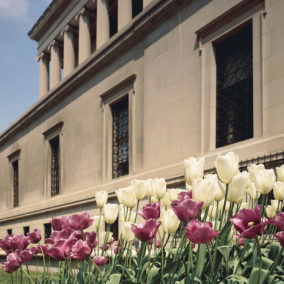
Temple Garden
The area in the back of the building provides for a parking lot, lawn, a storage garage and garden. Beautiful plants, flowers and vegetables are grown in the summertime. The lawn also features a statue of George Washington.
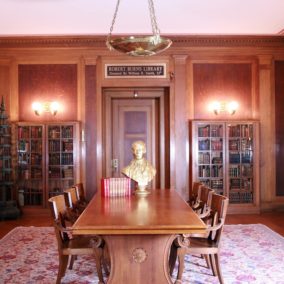
Robert Burns Library
The House of the Temple houses the second largest collection regarding poet Robert Burns in the world outside of Scotland. Burns is known as the Poet Laureate of Masonry. The collection was compiled and donated by William Smith, 32°, the former director of the U.S. Botanical Gardens. In addition to works by Bro. Robert Burns, the Library contains works about him and about Scotland, as well as “Chap Books,” some of which contain Burns’s poems, and others which reflect the times during which he lived.

International Library
The International Library was established in 1929. Today the collection has volumes about masonry from 63 different countries. The books and periodicals are written in the languages of their country. We have the greatest number of volumes from Britain and Canada. Masonic researchers can come and utilize the collection.

Albert Pike Museum
The Albert Pike Museum is a dedicated memorial to Albert Pike, who was Grand Commander of this Supreme Council from 1859 until his death in 1891, at the age of 82. During these 32 years, he wrote and compiled many books and became familiar with numerous languages, among them Latin, Greek, and Sanskrit. Pike is a highly regarded Masonic scholar, philosopher and historian. With his knowledge of languages, he conducted valuable research and rewrote the Rituals of the Ancient and Accepted Scottish Rite. His renown as a jurist, orator, philosopher, scholar, soldier, and poet extends throughout the world.
The Albert Pike Collection prominently features Pike’s personal Library. Also included in the displays are first editions and holograph copies of many of Pike’s works; his original desk, lamp, clock, and chair; many Personal items including Masonic regalia, and a representative sampling of his large collection of pipes.
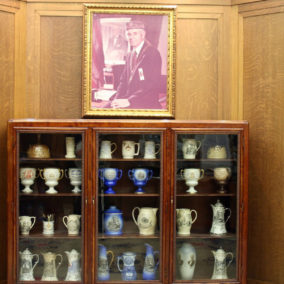
Past Sovereign Grand Commander’s Collection
This room contains a variety of interesting contributions from Past Sovereign Grand Commanders. Among them are a mounted collection of railway watches, portraits and busts of Past Sovereign Grand Commanders and the Kenneth S. Kleinknecht, 33°, exhibit honoring his significant contributions to America’s space program.

Sovereign Grand Commander’s Collection
The Grand Commander’s Collection features gifts given to the Grand Commander from around the world. Selections of fine porcelains include Royal Copenhagen, Royal Crown Derby, Boehm, Meissen china, and American cut glass. Housed in fine cabinets with Chinoiserie decoration, this unique collection reflects the international scope of the Scottish Rite
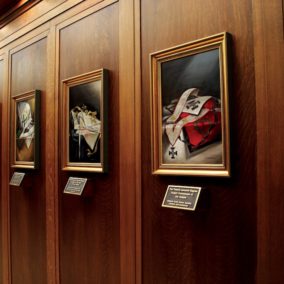
Hall of Scottish Rite Regalia
The Hall of Scottish Rite Regalia is one of the several special areas developed in the House of the Temple during the 1992-1993 Biennium. Located on the first floor between the office of the Director of Membership and the office of the Director of Development, the Hall is an educational and inspirational highlight for many visitors touring the House of the Temple. It consists of 36 original oil paintings by Bro. Robert H. White, 32°.
The concept behind the Hall of Scottish Rite Regalia was for Bro. White to create an artistic and ultra-realistic still life of the various elements (apron, cap, cordon, baldric, jewel, ring, gloves, etc.) of each of the Scottish Rite Degrees (4th through 33rd), including the honors of the Knight Commander Court of Honour and the Grand Cross. Also, for historical purposes only, paintings of the aprons for the first three Scottish Rite Degrees, as envisioned by Albert Pike, were also created. Brethren, unfortunately, seldom see some of the regalia associated with the non-obligatory Degrees. By having this regalia accurately and beautifully presented in the Hall of Scottish Rite Regalia, there is now a permanent, impressive record of these Masonic elements available via the paintings themselves to visitors to the House of the Temple and via color photographic reproductions on a special order basis to Brethren everywhere.
Custom cove lighting, modeled after that in the Temple Architects Hall of Honor, was installed in the Hall of Scottish Rite Regalia so that each painting is individually and dramatically illuminated. In addition, a bronze plaque placed under each painting in the Hall indicates the number of the Degree, its title, and a brief statement of its duties. Finally, a self-portrait by Brother White has been placed in the Hall as recognition of his dedication to the Rite and to this special project.

Masonic Philanthropies
The Masonic Philanthropies exhibit showcases the philanthropic programs that the Scottish Rite provides. The RiteCare Scottish Rite Childhood Language Program (SRCLP) offers facilities for the diagnostic evaluation and treatment of children with speech and language disorders, as well as learning disabilities. The exhibit includes testimonials and an inspirational video about the program. Another section features our Scottish Rite scholarship program, which provides scholarships to worthy students who meet the academic and community service requirements.

Americanism Museum
The Americanism Museum is dedicated to the Masonic principles of personal, social and intellectual freedom so important to our nation. It contains a number of captivating artefacts and relics from throughout American history. Here are displayed relics of the colonial and other periods of American history. For instance, there is a foundation stone from the White House which dates back to the original construction. Discovered during renovation started in 1948, the stone bears Masonic markings and is authenticated by a letter from former President Harry S. Truman, 33°. The collection also includes a replica life mask of President Abraham Lincoln and a lodge lantern used by a Union Army Lodge during the American Civil War, President Truman’s 33rd Degree Collar and various items from NASA that travelled to the moon.

Pillars of Charity
The Pillars of Charity is the only section of the building that has been significantly redesigned since the opening of the building in 1915. Pope’s vision for this area was a “light well” meaning light would come in through the Library windows and channel through a window illuminating the area. When they decided to build the pillars the design was respectful of Pope’s original idea. The area was created by one of the master carvers from the National Cathedral, Harold Vogel. The beautiful stained glass has 33 rays of light, the Scottish Rite’s double headed eagle, and a depiction of the House of the Temple.
This is where we honor donors who have been especially generous with their donations to the fraternity and its charities. The individuals honored here also have their portraits hanging downstairs in the Hall of Honor.
On either side of this area we have two busts; one of Albert Pike and one of John Henry Cowles.

Temple Architects Hall of Honor
The dedication of the Hall of Honor was one of the highlights of the 1991 Biennial Session. An original oil portrait of President Harry S. Truman, 33°, donated by the Scottish Rite Foundation of Missouri in 1990, was the premier painting installed in the Hall. Among them are such outstanding American Scottish Rite Freemasons as General James (Jimmy) Doolittle, 33°, G.C.; Gene Autry, 33°, G.C.; Dr. Norman Vincent Peale, 33°, G.C.; Will Rogers, 32°; Senator Sam J. Ervin, 33°; and Bishop Carl J. Sanders, 33°, G.C.
In order to assure an aesthetic harmony to this very special area in the House of the Temple, all Hall of Honor paintings are commissioned by the Supreme Council from Jean Pilk, a well-known portrait artist who has created official portraits for such notables as Supreme Court Justice Sandra Day O’Connor (Ret.), Former Virginia Governor L. Douglas Wilder, and General Colin Powell,(US Army Ret.). In addition, special lighting and a custom-woven carpet complete the Hall’s distinctive character. In upcoming years, this illustrious pantheon of Masonic heroes, both past and present, will be completed with pride by the Scottish Rite, for in donating a portrait to the Temple Architects Hall of Honor, the Brethren not only honor our nation’s most outstanding Scottish Rite Masons, but also give support to the House of the Temple, thus preserving it for generations to come.

Cornerstone Hall of Freedom
The Cornerstone Hall of Freedom was added to the House of the Temple to commemorate the bicentennial Masonic reenactment in 1993 of the laying of the cornerstone of the U.S. Capitol. The stone used during the ceremony, a perfect 18-inch cube, serves as the exhibit’s centrepiece. The display also includes other memorabilia from the event including a photographic collage, a replica of the engraved silver plate affixed by George Washington under the original stone, a copy of an 18th-century Masonic apron, and a print of the painting, “George Washington Laying the Cornerstone of the U.S. Capitol, Sept. 18, 1793,” by Ill. John D. Melius, 33°.

Frederick Dalcho’s 33rd Degree Patent
The earliest known patent the Supreme Council issued, this illuminated document, dated May 25, 1801, certifies Ill. Bro. and Rev. Frederick Dalcho—among many titles—a 33° Scottish Rite Mason, Sovereign Grand Inspector General, and “Lieutenant Grand Commander for Life of the Supreme Council of the 33rd degree in the United States of America.”
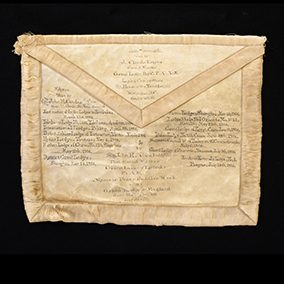
The “Traveling” Apron
This “jet-setting“ piece from our textiles collection, made of leather, satin, and silk, dates back to 1911 and is inscribed with the names of the Freemasons who wore it and where they traveled, beginning with MW J. Claude Keiper, Grand Master of DC, FAAM, at the cornerstone laying of our very own House of the Temple in Washington, DC. During its many documented journeys in 1926 with Sovereign Grand Commander John Henry Cowles, 33°, the apron traveled to lodges in Hawaii, Japan, China, the Philippines, Egypt, Turkey, Romania, and the Czech Republic (then Czechoslovakia).

Masonic Punch Bowl
This hand-painted, ca. 1790–1810 Masonic punch bowl is one of four similar-yet-distinct “English white” bowls in the collection. The House of the Temple received these in 2016 from the estate of Ill. Claude H. Harris, Jr., 33°, Past Master of Alexandria-Washington Lodge No. 22, and a member of the Scottish Rite Valley of Alexandria, VA.

Like other bowls from this collection, around its exterior basin, you can find a number of significant symbols in Freemasonry, including working tools, such as the sector, protractor, parallel ruler, and—of course—the square and compasses. Depictions of the sun, moon, seven stars of the Pleiades, and the waters of heaven (or waterfall), decorate the bowl’s interior sides, and in the bottom lies the checkered pavement and the pillars Jachin & Boaz with a letter G between them.
This bowl and its three companions currently are on display in the Grand Archivist’s Collection.

Circular throughout the Two Hemispheres
On Dec. 4, 1802, about 18 months after its creation in Charleston SC, the Supreme Council issued its first publication, the Circular throughout the two Hemispheres. One of the Scottish Rite’s founding documents, this work, also known as the “1802 Manifesto,” not only announced the establishment of the Supreme Council but also addressed its operations and the degrees it controlled.

Light Calvary Sword Presented to Albert Pike by Benjamin B. French
Serving as a symbol of the bonds of Freemasonry during the Civil War, this engraved light cavalry sword was given by Benjamin B. French, Grand Master of the Grand Encampment of the Knights Templar, who worked in the Lincoln administration, to Albert Pike, a brigadier general in the Confederate Army. The Grand Lodge of Louisiana presented this sword to the House of the Temple Library & Museum on May 23, 2019. The inscription on the sheath reads, “Presented to / General Albert Pike / C.S.A. / By Sir B. B. French G.M. / August 16, 1861,” the date Pike was made brigadier general in the Army.

Shepheard’s Tavern Doorknocker
This brass doorknocker, now mounted on the Executive Chamber’s door, originally graced that of the Supreme Council chamber at Shepheard’s Tavern—the birthplace of the Scottish Rite. On May 31, 1801, the Supreme Council, 33°, convened for the first time at that tavern, located at the corner of Church and Broad Streets in Charleston, SC.
Illustrious Frederick Webber, 33°, Secretary-General (1886–1907) and SGIG in Kentucky (1859–1907), originally gave the brass doorknocker to Philip Schuyler Malcolm, 33°, SGIG in Oregon (1911–29). Ill. Malcom later donated it to the House of the Temple on Dec. 28, 1915, shortly after the building’s grand opening.

Audie Murphy’s US Army Dog Tags
On display in our Americanism Museum, these US Army dog tags belonged to Ill. Audie Murphy, 33°, the most decorated US soldier during World War II. In addition to his name, they bear that of his eldest sister, Corinne Burns, as his next of kin.
At the young age of 19, Ill. Murphy was awarded the Congressional Medal of Honor and, by the end of the war, he had received every US military combat award for valor available from the US Army. After his time in the military, he became a notable actor, appearing in more than 40 feature films. Ill. Murphy was a Scottish Rite Mason and received the KCCH in 1965 and the 33° posthumously in 1999.

Scottish Rite 18th Degree, Knight Rose Croix, Jewel
This beautifully detailed 14k-gold, 18°, Knight Rose Croix, jewel was given to Past Wise Master Walter Roland Coombs by the Honolulu, Hawaii, Scottish Rite Bodies on Sep. 24, 1915. In the Scottish Rite, SJ, the Wise Master presides over the Chapter of Rose Croix, or the 15°–18°.
The front side of the medallion features a pelican feeding its young with a sprig of acacia, a rose, and a Passion cross above it. The reverse side has an eagle and a Passion cross. Both birds appear underneath crowned compasses and rest upon an arc.

Royal and Select Masters Commemorative Tyg, or Pass Cup
Thomas Maddock’s Sons Co. of Trenton, NJ, created this purple and gold tyg (tig), which celebrates the 50th anniversary (1860–1910) of Gebal Council No. 3 of the Royal and Select Masters, also of Trenton. Tygs possess three handles so people more easily can share, or “pass,” them off to each other. The cup’s other two sides feature: 1) a trowel within a triangle, a symbol of “Cryptic Masonry,” and 2) 27 stars (the highest number of members a Council can possess), arranged where 24 of them encircle three larger ones (the principal officers).
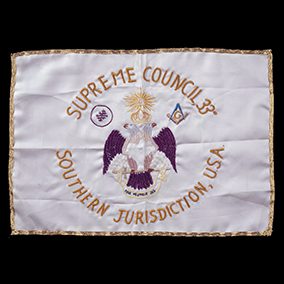
Supreme Council, 33°, SJ Apollo XI Flag
“When man reaches new worlds, Masonry will be there.”
—The Scottish Rite Journal, December 1969
In July 1969, this Supreme Council, 33°, Southern Jurisdiction, flag traveled to the moon and back with NASA astronaut Ill. Edwin E. “Buzz” Aldrin, 33°, on the historic Apollo XI shuttle mission. Hand sewn by Supreme Council Librarian Inge Baum, the gold-bordered, white silk flag measures 11.81 in. wide by 8.66 in. long and features the 33° Double-headed Eagle in its center. To the left of the eagle is the official emblem of the Sovereign Grand Commander—a purple right-leaning Cross of Salem with crosslets—and to the right, a square & compasses with the letter G in its center.

Masonic Gavel from King Solomon’s Quarries, Jerusalem
The top of this Masonic gavel was created out of material taken from an ancient underground quarry that extends beneath Old Jerusalem, called “King Solomon’s Quarries.” Its handle is made of genuine olive wood, and its head of sandstone, into which is carved a square and compasses with the letter “G” in its center. The unique piece comes from the collection of Ill. John Henry Cowles, 33°, who served as the 13th Sovereign Grand Commander of the Scottish Rite, SJ, USA, from Oct. 18, 1921 to Oct. 6, 1952.

White House Piece with Stone Masons’ Marks
This original stone from the White House currently resides our Americanism Museum.
Not long after World War II, Ill. Harry S. Truman, the 33rd U.S. president and a 33rd Degree Scottish Rite Mason, expressed concerns regarding the structural integrity of the White House, a sentiment echoed by others who “said the White House was standing only from the force of habit.”* An extensive renovation project followed, which lasted from 1948 to 1952.

During an inspection of the work site, Ill. Truman realized some of the original excavated stones contained stone masons’ marks, like that of the square and compasses on this piece.† He donated one of these stones to the Supreme Council, 33°, S.J., on November 22, 1952. A small plaque at this stone’s base bears the presidential seal and reads “Original White House Material / Removed in 1950.”
*“The White House Is Falling Down: About this Gallery,” The White House Historical Association, accessed September 24, 2019, https://www.whitehousehistory.org/galleries/the-white-house-is-falling-down
†“The White House Stone with a Mason’s Mark,” Minnesota Masonic Heritage Center, August 31, 2017, accessed September 24, 2019, https://www.masonicheritagecenter.org/2017/08/white-house-stone-masons-mark/






